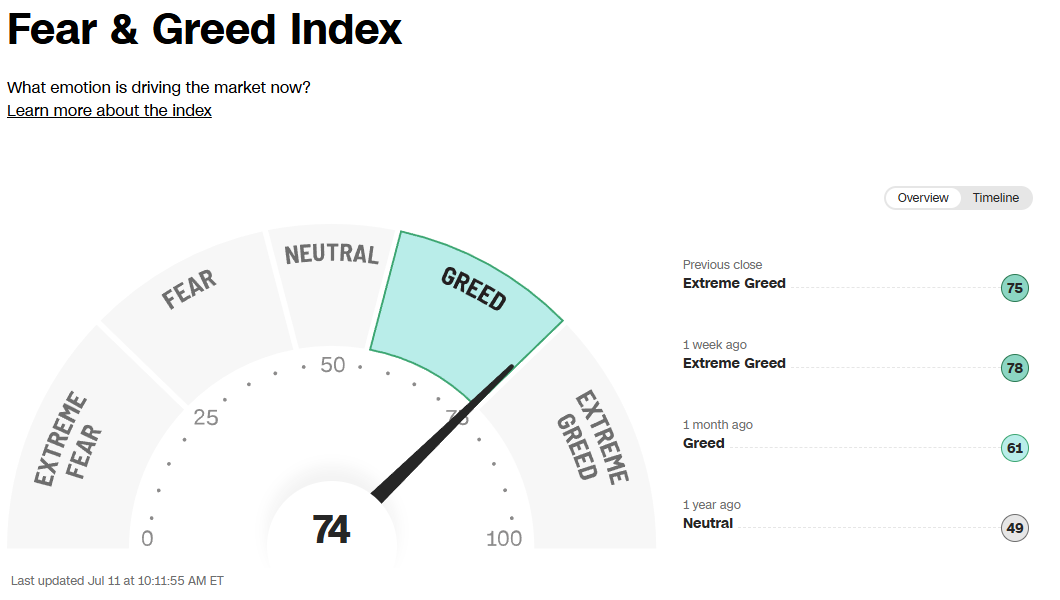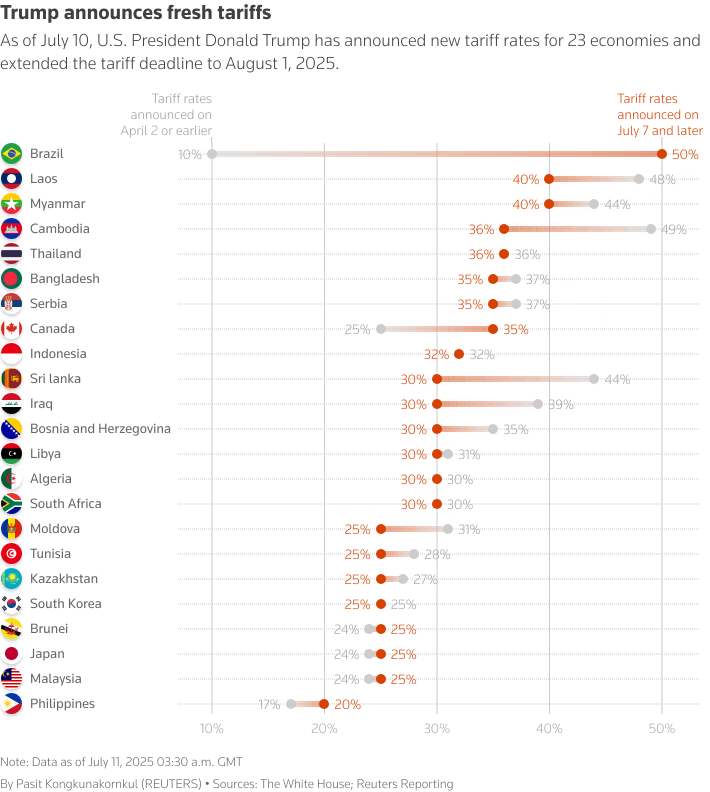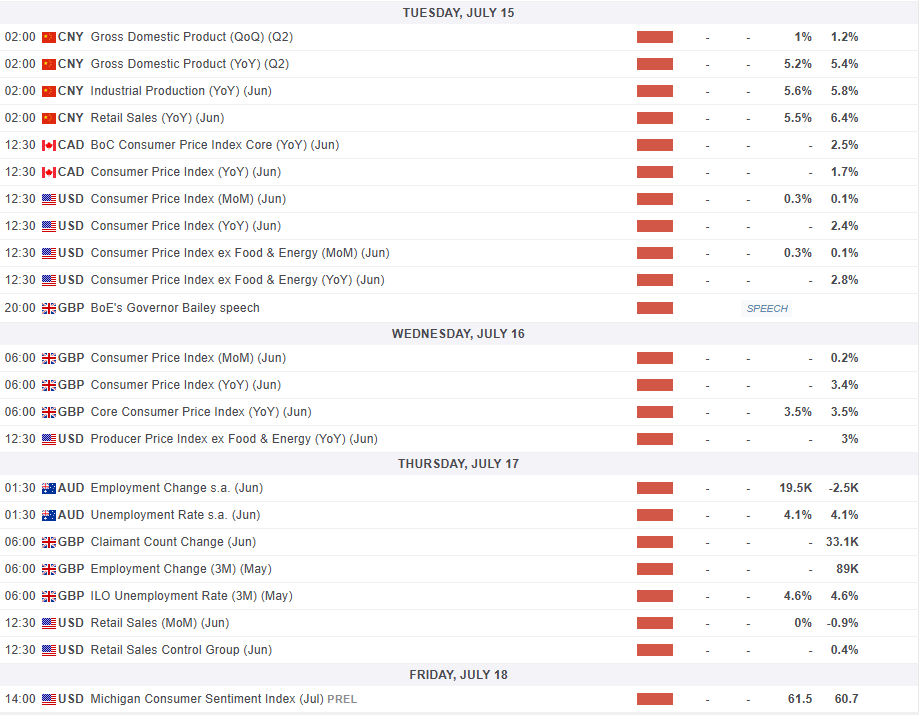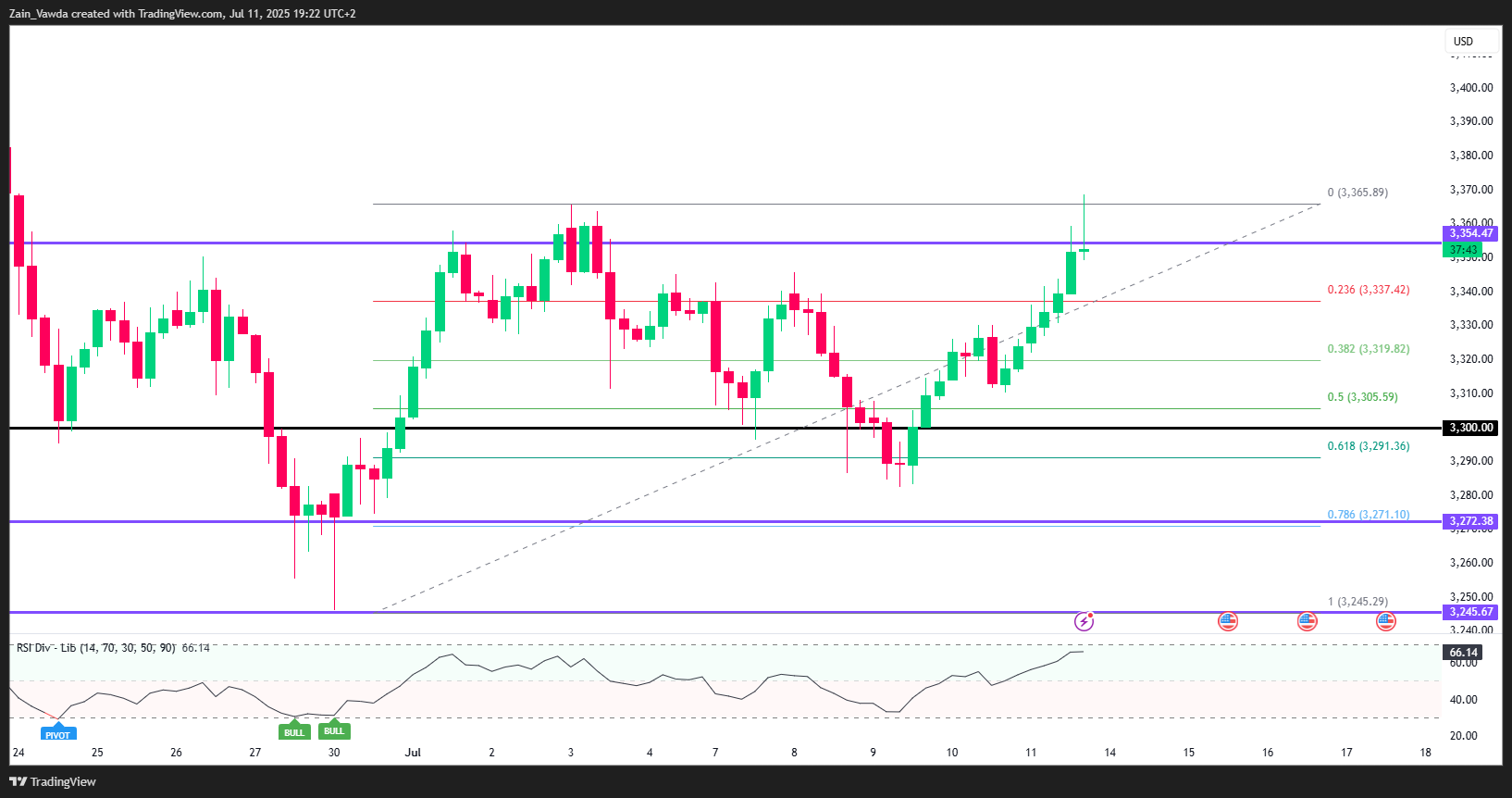Michigan survey ahead; Applied Digital surges; gold dips - what’s moving markets
Week in review: Tariff Uncertainty Drags On
The July 9 tariff deadline has come and gone, and market participants are still left with a lot of questions. Trade deals have begun to filter through, but the majority of countries are still locked in negotiations with the US as the tariff implementation date of August 1 beckons.
The lack of high-impact US data this week left markets with tariffs and trade deals to focus on. In typical Donald Trump style, the US President did not disappoint. Levying new tariffs on allies and other countries while urging them to ‘keep working hard’ in the tariff discussions.
The Fear and Greed index remains comfortably in greed territory despite the uncertainty, which continued this week.
Source: FinancialJuice
On Thursday, Trump announced a 35% tariff on Canadian imports starting next month, increasing from the 25% set in March. He also warned the tariff could go even higher if Canada fights back.
Trump also suggested raising tariffs on other countries to 15% or 20%, up from the current 10%.

Source: LSEG
The market reacted more calmly to the new tariff announcements compared to the sharp drops seen after April’s "Liberation Day," when major indexes had their worst weekly losses in nearly six years.
The S&P 500 and Nasdaq are heading for a slight drop this week, while the Dow is set to break its three-week winning streak, the longest since January. Nvidia (NASDAQ:NVDA) made history by becoming the first company to reach a $4 trillion valuation, with its shares hitting a new record high.
The reaction by Gold may be a sign that market participants are still concerned about the uncertainty. The precious metal roared to life at the back end of the week, rising to trade at 3365/oz at the time of writing.
Cryptocurrencies were another winner this week with Bitcoin in particular faring excellently. The World’s largest cryptocurrency rose to fresh all-time highs as institutional investors continue to pile in.
Earnings Season is Back. What to Expect?
Earnings season will kick into gear in the US next week, and with tariffs yet to begin, one wonders if it may mirror the Q1 run, with a lot of caution and concerns being noted by major corporations.
Investors are looking ahead to understand how trade issues have affected businesses in the US and what businesses are expecting moving forward into Q3 and beyond. Given that tariffs are yet to be implemented, market participants may be left with more questions than answers once more, and such uncertainty could weigh on US equities.
However, if companies do provide optimistic updates and we do get a flurry of trade deal announcements, US equities could continue to advance.
Asia Pacific Markets
In China, Trade data on Monday is expected to show slight growth in exports and imports, with little sign of trade frontloading during the tariff pause.
Second-quarter GDP is expected to stay around 5% year-on-year. Housing price data will reveal if recent declines continue or were temporary. Another big drop may lead to more real estate stimulus, with a possible meeting in the week ahead to discuss it.
Retail sales have been strong, but industrial production and investment have weakened. Markets expect this mixed trend to continue in June.
In Japan, June exports are expected to rebound, with stronger growth to Asia (excluding China) and the EU, while exports to China and the US may lag due to tariffs.
Machinery orders are expected to show a slight increase, supported by strong tech investment. Friday’s CPI report should show a slight drop in pressure due to capped energy and food prices, but inflation will likely stay above 3%.
Economic Data from Europe, UK, and the US
In developed markets, US inflation takes center stage. Inflation has been steady recently, with monthly increases of 0.1% and 0.2%. However, I expect it would take about three months after the tariffs for their effects to appear. This means the July, August, and September CPI reports will likely show a bigger impact. There is a possibility that core CPI will rise in Tuesday’s report and may be worth monitoring.
Looking at the Euro Area, we have a few data releases to pay attention to.
The Euro Area saw strong growth in production and exports in the first quarter, driven by frontloading before “Liberation Day,” April saw declines as those effects faded. However, industrial production in April was still higher than in January.
While new orders show signs of stabilizing, it seems April’s production levels were still boosted by frontloading. The key question is whether the tariff pause caused another wave of frontloading or if production and exports have returned to normal or even dropped due to higher tariffs.
May data will be crucial in understanding this and will provide a clearer picture of second-quarter GDP trends.
Moving to the UK, we have both jobs and inflation data on deck next week.
On the inflation front, all eyes will be on UK service inflation, which is expected to drop further, likely giving the Bank of England confidence to cut rates again in August. There will be even more pressure for a cut after the UK GDP release on Friday.
Job numbers are more important for markets than inflation next week. In May, payrolled employee numbers fell at the fastest rate since 2014 (excluding the pandemic). This data might be revised higher, but if it isn’t and if June’s numbers are also bad, it could push the Bank of England to speed up rate cuts.

MarketPulse Economic Calendar
Chart of the Week - Gold (XAU/USD)
This week’s Chart of the Week is Gold (XAU/USD).
Gold has shrugged off its early week decline with an eye on three successive days of gains to end the week.
The precious metal is benefiting from tariffs imposed by Donald Trump this week on a host of countries, including neighboring Canada.
The lack of concrete trade deal announcements only adds to the confusion, as market participants surely cannot wait for an end to the saga.
From a technical standpoint, Gold bounced from the golden pocket Fibonacci area between the 61.8-78.6 and printed a fresh high.
The question heading into next week will be whether there will be follow-through and if the precious metal can regain the $3400/oz handle.
This is likely to depend on the developments around tariffs and trade deals, which will likely remain the driving factor for the precious metal and either fuel haven demand or lead to some form of unwinding, should a flurry of trade deals be announced.
Gold (XAU/USD) Four-Hour (H4) Chart - July 11, 2025
Source:TradingView.Com
Key Levels to Consider:
Support
- 3337
- 3325
- 3300
Resistance
- 3375
- 3400
- 3425
